|
Kuntaw was developed in the
Philippines.Kuntaw primarily was developed as a defensive art, but it can be
used as an offensive art given the right circumstances.It handles the three
ranges of battle: Largo (long); Sumbrada (short); and Hubud (close) ranges
as well as the three altitudes of fighting: air, standing and ground. |
 |
|
Fighting skills come from many
different areas of the Orient. However, the three main, in which Kuntaw took
from, were Kali
-gave destruction of the weapon, Kempo gave destruction to the body and
Pencak Silat
gave destruction of the base to Kuntaw. Kali introduced the idea of the
sword, Kempo gave the idea of powerful kicks
and punches and from Pencak Silat came the circular, flowing, snake-like
movements. The three main Filipino Arts which Kuntaw is comprised of are
Buno (Philippine
Wrestling), Sikaran
(kicking Art) and Bugtongan (Philippine Stick Fighting system).
Weapons may be a fist, elbow, knee, foot, mind, or a hand held object such
as a knife, stick or sword. Movements in Kuntaw were developed from the use
of these weapons and from the defense of these weapons. Though Kuntaw is
basically evasive, it is a dramatic evasiveness. The movements used are
light and fast to avoid an attack, but they are designed too use this action
to counter back to the opponent. These movements do not stop an attack or
oppose the force delivered; instead they redirect the force back to the
source by gaining control of the force. In effect, using the opponent’s own
force against them without using or wasting much of your own energy or using
any force. These movements direct a delivered force to an area or position
that allows the practitioner to get in and take the opponent's base or
balance. This gives the Kuntawista the ability to lock, throw or sweep the
opponent to the ground. |













